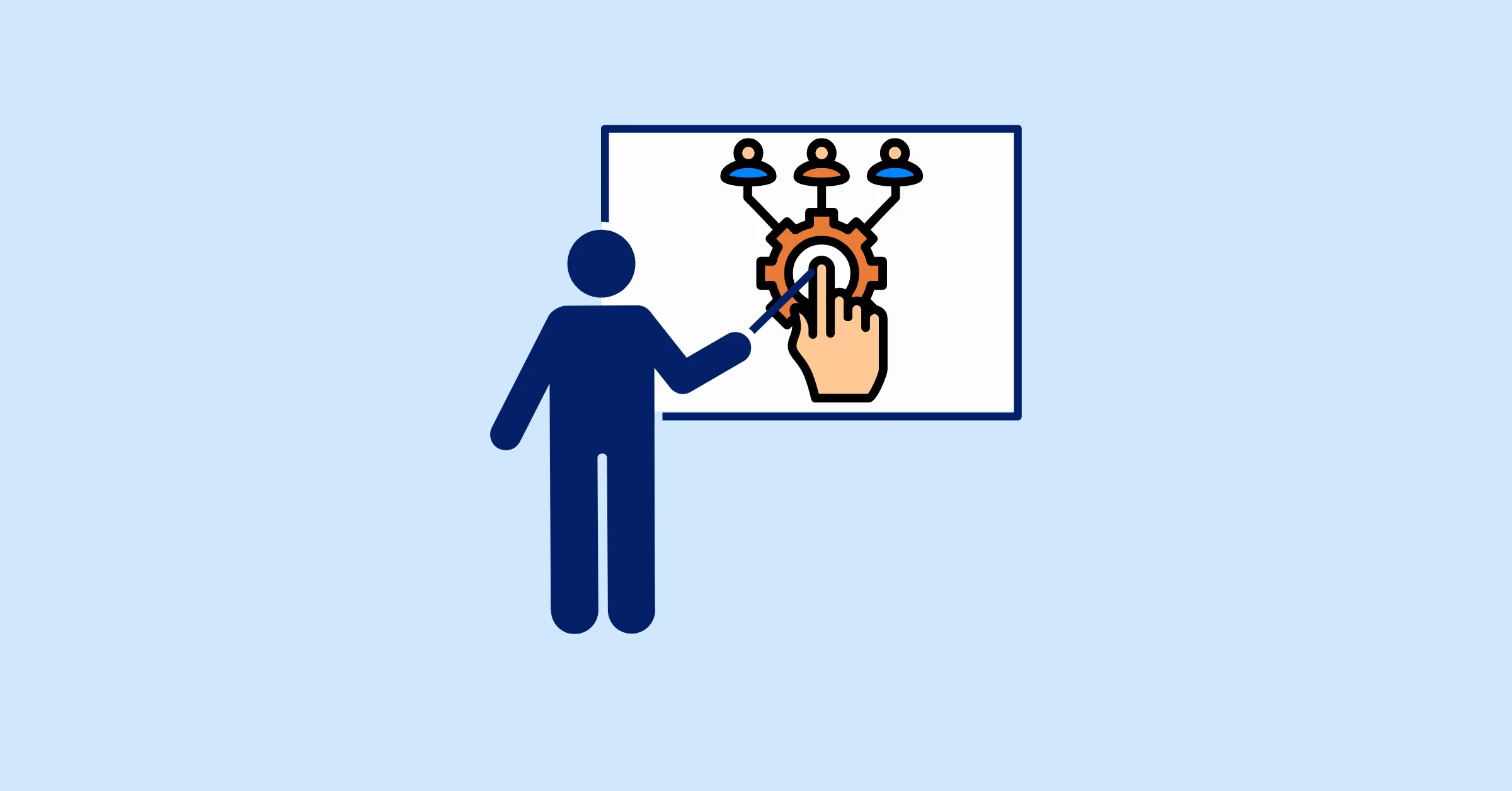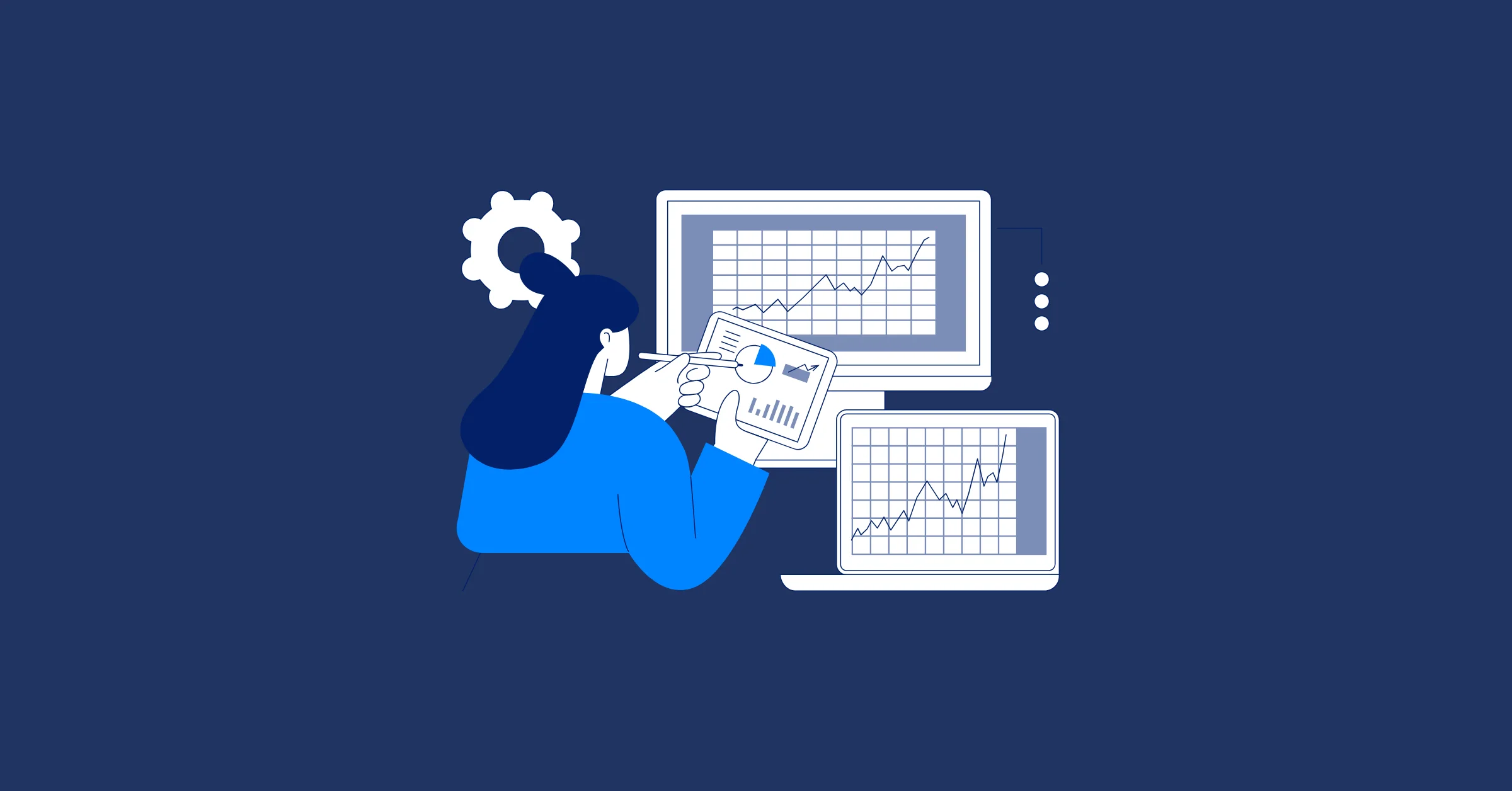Crafting a Resource Management Plan: A Project Manager's Handbook
Learn how to create a practical resource management plan to keep projects on track, teams happy, and budgets in check. Your essential PM handbook!
Okay, let's talk project management. You're juggling tasks, deadlines are looming, stakeholders have expectations, and somewhere in the middle of all that... are your resources. People, equipment, budget, even time itself. It can feel like spinning plates, right? One wrong move and crash. We’ve all been there, feeling stretched thin, wondering if we have the right people on the right tasks, or if we'll blow the budget acquiring that one critical piece of software. It’s stressful! This is precisely where a solid resource management plan comes in – not as another piece of bureaucratic paper, but as your genuine roadmap to calmer waters and smoother sailing.
Honestly, skipping this step is like trying to bake a complex cake without knowing what ingredients you have or how much you need. Sure, you might end up with something, but it probably won’t be the masterpiece you envisioned. A well-thought-out resource management plan is fundamental to successful project management. It’s about being intentional, not just reactive.
Key Takeaways
- Clarity on Needs: Understand exactly what and who you need, and when you need them. No more guessing games.
- Avoid Burnout & Bottlenecks: See potential overallocations before they happen, keeping your team healthy and productive.
- Stay on Budget: Track resource costs effectively, preventing nasty surprises down the line. Linked heavily with good cost management.
- Improve Project Predictability: Increase the chances of hitting deadlines by ensuring resources are available when needed.
- Boost Team Morale: Fair allocation and clear roles mean less confusion and frustration for everyone involved.
- Efficient Resource Planning: It forms the backbone of knowing capacity vs. demand.
So, What Exactly Is This Resource Management Plan Thing?
Right, let's demystify this. At its heart, a resource management plan is a document (or, let's be real, often a section within your main project planning document) that outlines precisely how you're going to identify, acquire, manage, and release all the resources needed for your project.
Think beyond just your team members. We're talking:
- Human Resources: The people! Their skills, availability, roles, reporting structures.
- Equipment: Computers, software licenses, machinery, testing devices, vehicles – anything tangible needed to do the work.
- Facilities: Office space, meeting rooms, labs, production floors.
- Financial Resources: The budget allocated specifically for resources (salaries, fees, purchase costs, rentals).
- Materials: Consumables, raw materials, components.
- Technology: Specific software (beyond general equipment), cloud services, APIs.
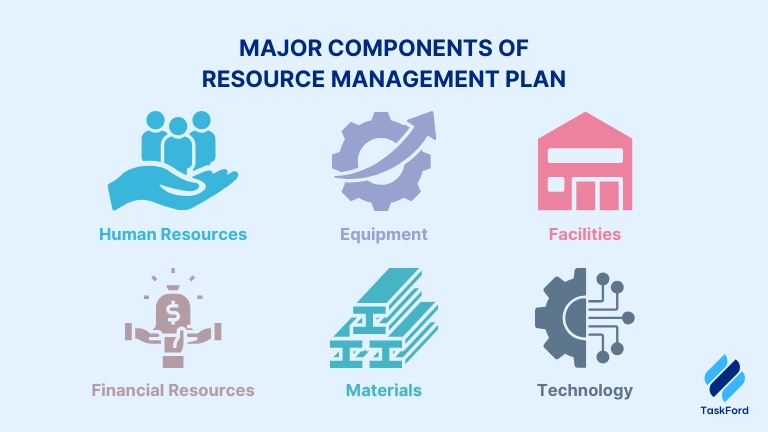
Basically, if it's needed to get the project done, it belongs in your thinking for the resource management plan. It's not just a list; it’s the strategy for handling these assets throughout the project lifecycle. It answers the crucial questions: What do we need? When do we need it? How do we get it? Who manages it? How do we make sure it’s used effectively? How much will it cost (budget management is key here!)?
Without this plan, you're essentially flying blind. You might overestimate, leading to wasted budget. Or, more commonly, you underestimate, leading to frantic scrambling, delays, and stressed-out teams. You know the drill. A resource management plan brings order to that potential chaos.
Why Should I Even Bother? The Real-World Payoffs
"Okay, fine," you might be thinking, "another plan to create." I get it. Project managers are drowning in documentation sometimes. But trust me, the effort you put into a resource management plan pays back tenfold. It's not just busywork; it's risk mitigation and efficiency creation rolled into one.
Here’s the real deal on why it matters:
- Prevents Overallocation and Burnout: This is huge. A resource management plan helps you visualize who is working on what, across potentially multiple projects (portfolio management comes into play here for larger orgs). You can spot when Sarah is assigned 60 hours of work in a 40-hour week before she hits the wall. Tools that help with resource planning often have dashboards specifically for this. Seeing this early allows you to adjust workloads, bring in extra help, or reprioritize tasks. Happy, healthy teams are productive teams.
- Ensures You Have the Right Skills: It forces you to think critically about the specific skills needed for each task, not just assigning work to whoever seems free. Do you need a junior developer or a senior architect for this phase? A graphic designer or a UI/UX specialist? The plan makes you define this upfront.
- Keeps Budgets Under Control: Resources cost money. People's time (salaries/rates), software licenses, equipment rentals – it all adds up. Your resource management plan directly feeds into your cost management efforts by detailing anticipated resource expenses. Tracking actual usage against the plan helps you spot variances early.
- Minimizes Project Delays: How many projects get delayed because a key person is unavailable, or a necessary piece of equipment wasn't booked? A proactive resource management plan anticipates these needs and schedules resource acquisition and allocation accordingly. It smooths out the bumps before they derail your timeline. Effective time management for resources is critical.
- Improves Communication and Transparency: When everyone knows the plan – who is responsible for what, when resources are expected to be available, and how allocation decisions are made – it reduces confusion and potential conflicts. It sets clear expectations.
- Foundation for Effective Task Management: Knowing who is available and capable directly informs how you assign individual tasks. Your resource management plan provides the context needed for day-to-day task management to function smoothly.
Honestly, neglecting the resource management plan is like setting off on a road trip without checking if you have enough gas, if the car is working, or if you even packed snacks. You might get there, but it’s going to be a much bumpier, more stressful ride.
Okay, So How Do We Actually Do This? The Steps Involved
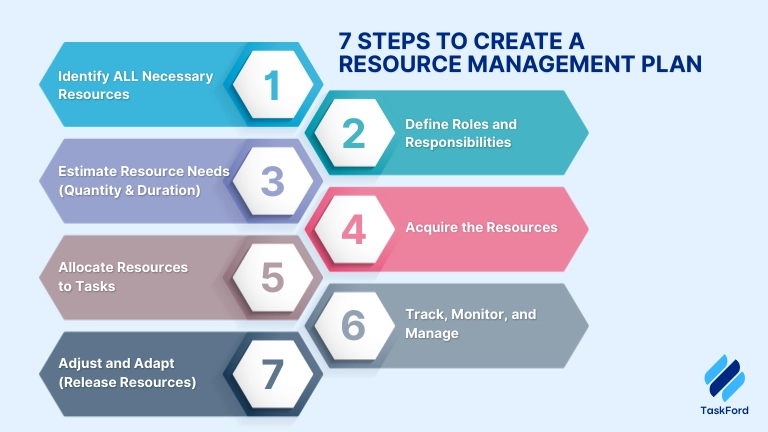
Alright, let's get practical. Creating a resource management plan isn't rocket science, but it does require thoughtful effort. Here’s a breakdown of the typical steps:
Step 1: Identify ALL Necessary Resources
First things first, you need to figure out everything you'll need. Go back to your project scope and work breakdown structure (WBS). For each major task or phase, ask:
- Who needs to be involved? (Think roles and skillsets, not necessarily specific names yet)
- What tools or equipment are essential? (Software, hardware, machinery)
- Are there specific facilities required? (Meeting rooms, labs)
- What materials will be consumed?
- What’s the estimated budget for these resources?
Don't just skim the surface here. Think about support roles, administrative help, testing environments, licenses – the works. It’s better to list too much and refine later than to miss something critical. This is the foundational step of resource planning.
Step 2: Define Roles and Responsibilities
Once you know the types of human resources needed, clearly define their roles within the project context. What are the key responsibilities for the developer, the tester, the designer, the subject matter expert? Who reports to whom? A RACI chart (Responsible, Accountable, Consulted, Informed) can be super helpful here, even a simple version. Clarity prevents turf wars and ensures someone owns each part of the resource puzzle.
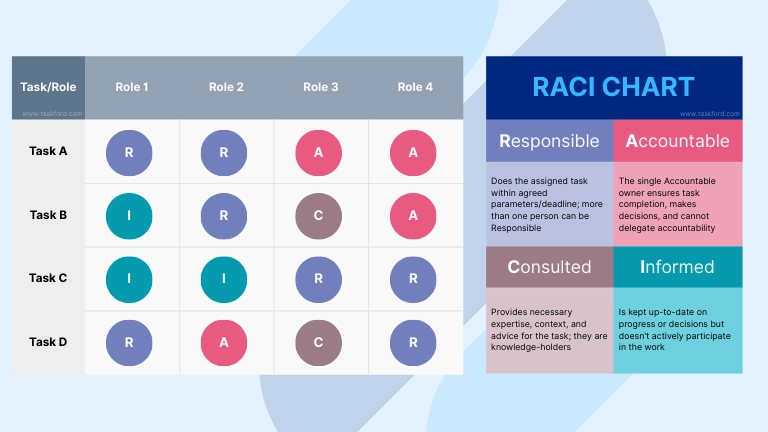
Step 3: Estimate Resource Needs (Quantity & Duration)
This is where you put numbers to the names and items. For each resource identified:
- How much? How many people with X skill? How many software licenses? How many hours of machine time?
- For how long? When do you need them? Is it full-time for six months, or 10 hours a week for three weeks?
Be realistic! Consult with functional managers or team leads if possible. Factor in holidays, potential sick leave, and the learning curve for new tools or team members. Underestimating here is a classic pitfall. Tools integrating project management and resource planning can help visualize this against timelines.
Step 4: Acquire the Resources
Now you know what you need, you have to actually get it! This might involve:
- Internal Allocation: Negotiating with functional managers for internal team members.
- Hiring: Recruiting new employees or contractors.
- Procurement: Purchasing equipment, materials, or software licenses.
- Booking: Reserving facilities or shared equipment.
This step often has lead times, so start early! Your resource management plan should outline the process for acquiring each type of resource.
Step 5: Allocate Resources to Tasks
Okay, you have your resources! Now, assign them to specific tasks or activities outlined in your project schedule. This is where your resource management plan meets your task management system. Be specific. Don't just say "developers work on feature X." Say "Jane (Senior Dev) allocated 20 hours/week for tasks 1.2.1-1.2.3 starting May 15th."
Watch out for overallocation! Check individual workloads. Does the allocation align with their availability defined earlier? This is a continuous balancing act.
Step 6: Track, Monitor, and Manage
A plan is useless if you don't track progress against it. This involves:
- Monitoring Usage: Are resources being used as planned? Are people logging their time accurately (time tracking and timesheet management are vital here)? Is equipment functioning?
- Tracking Costs: Keep an eye on spending against the resource budget (cost management integration is golden).
- Assessing Performance: Are resources delivering as expected? Are there skill gaps or performance issues?
- Regular Check-ins: Talk to your team! Are workloads manageable? Are there any roadblocks?
This isn't about micromanaging; it's about staying informed so you can make adjustments proactively. Many modern project management tools offer dashboards for this. Some popular options you might encounter include Monday.com for its visual approach, Smartsheet leveraging spreadsheet familiarity, or ClickUp aiming for an all-in-one experience. An integrated tool can make this step much less painful.
Step 7: Adjust and Adapt (Release Resources too!)
Projects rarely go exactly according to plan. Priorities shift, people leave, equipment breaks, scope creeps. Your resource management plan needs to be a living document.
- Reallocate: If someone is overloaded, can tasks be shifted? If someone is underutilized, can they help elsewhere?
- Acquire More (or Less): If scope increases, you might need more resources. If tasks finish early, release resources so they aren't sitting idle (and costing money!).
- Update the Plan: Document any changes made. This keeps everyone informed and provides valuable data for future project planning.
Don’t forget the ‘release’ part! Clearly define when a resource (person, equipment rental) is no longer needed for your project so it can be reallocated or decommissioned properly.
Uh Oh… Common Pitfalls to Watch Out For
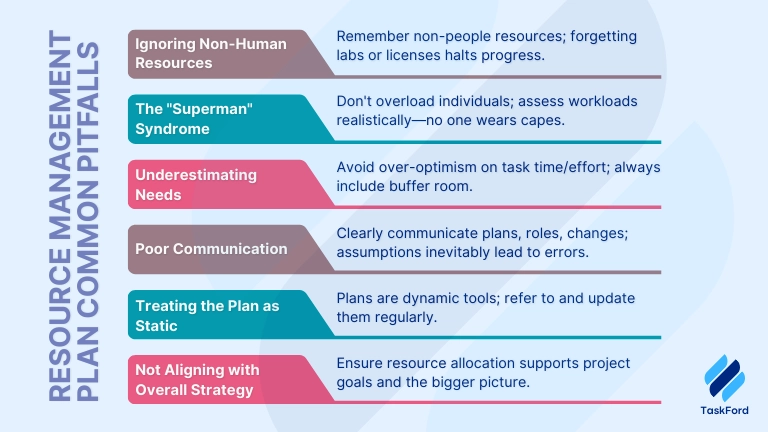
Creating and executing a resource management plan sounds great on paper, but there are common traps. Being aware of them is half the battle:
- Ignoring Non-Human Resources: It's easy to focus only on people. Forgetting to book the testing lab or renew that critical software license can halt progress just as easily as a key person being unavailable.
- The "Superman" Syndrome (Over-allocation): Assigning one person too many critical tasks, assuming they can handle it all. Check workloads realistically. Nobody wears a cape to work (usually).
- Underestimating Needs: Being overly optimistic about how long tasks will take or how much effort is required. Always buffer slightly.
- Poor Communication: Not clearly communicating the plan, roles, or changes to the team and stakeholders. Assumptions lead to errors.
- Treating the Plan as Static: Creating it once and never looking at it again. It must be a dynamic tool you refer to and update regularly.
- Not Aligning with Overall Strategy: Does your resource allocation support the project's main goals? Is the resource management effort connected to the bigger picture, perhaps even at the portfolio management level?
Sidestep these by being thorough in your initial planning, communicating openly and often, using appropriate tools for tracking, and revisiting/updating your resource management plan regularly.
Don't Rely on Tools Alone, but Tools can help a lot!
You can manage resources with spreadsheets, especially for smaller projects. But as complexity grows, dedicated software becomes invaluable. Look for tools that help with:
- Visualization: Seeing timelines, allocations, and availability at a glance.
- Capacity Planning: Matching resource availability against project demand.
- Time Tracking: Capturing actual effort spent (time tracking features are essential).
- Reporting: Generating reports on utilization, costs, and potential bottlenecks.
Many project management software suites include resource management capabilities. For instance, TaskFord (the platform we're building) aims to integrate project management, task management, cost management, resource planning, time tracking, and timesheet features seamlessly, which could significantly simplify creating and managing your resource management plan in the future.
Remember, though, a tool is just a tool. It's the process and the thinking behind the resource management plan that truly matter. The software just makes executing and monitoring that process easier.
Beyond the Document: Fostering a Resource-Aware Culture
A truly effective resource management plan isn't just about the document you create. It's about fostering a culture where resources are valued and managed wisely across the board. This involves:
- Transparency: Make resource availability and allocation visible (where appropriate).
- Communication: Encourage open discussion about workloads and potential issues.
- Training: Ensure team members understand how to track their time and report progress accurately.
- Collaboration: Foster cooperation between project managers and functional managers for smoother resource sharing.
- Continuous Improvement: Learn from each project. What worked well in your resource management plan? What didn't? Use those lessons learned.
Think of it like time management for the collective – being mindful of how everyone's capacity and the project's assets are being used.
Wrapping It Up: Your Resource Compass
Crafting a resource management plan might seem like an extra hurdle, but it’s genuinely one of the most powerful tools in a project manager's arsenal. It transforms resource handling from reactive firefighting to proactive strategy. It’s your compass for navigating the complex terrain of project execution, helping you keep your team engaged, your budget intact, and your project heading towards successful completion.
It’s not a one-and-done document you file away. It’s a dynamic guide that evolves with your project. Embrace the process, communicate openly, use the right tools to help, and you'll find your projects run much more smoothly. You've got this!
Want to be the first to know about tools that simplify this?
Excited about a future where managing projects, tasks, costs, and resources feels less chaotic? TaskFord is building a solution designed to integrate these crucial elements seamlessly.

Making work simpler,
smarter, and more connected
Join our waitlist and be notified first.

Related Blog
Subscribe for Expert Tips
Unlock expert insights and stay ahead with TaskFord. Sign up now to receive valuable tips, strategies, and updates directly in your inbox.



